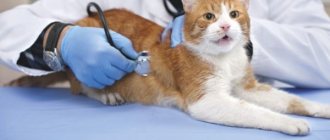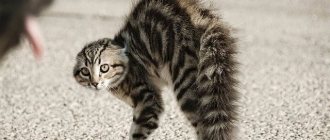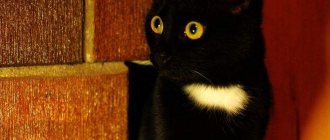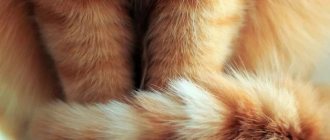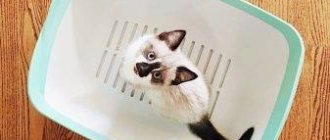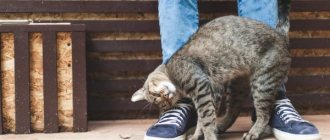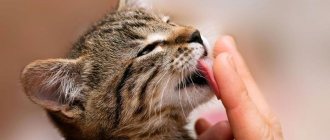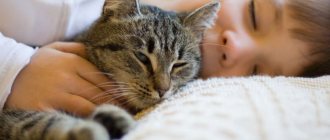Many of us have a cat living in our house, which means the situation is close when every evening she jumps onto her lap and begins to methodically step from paw to paw. The question arises - why does a cat trample you with its paws?
There are several answers, but one thing is clear, none of them are 100% true.
This cat behavior is observed when the owner is resting. Jumping onto his lap, she first rubs her hands, and then licks them, and only then begins her ritual of massaging the owner’s body. In this way, the animal releases fatigue, negative energy, and negative emotions from its breadwinner, improving his condition at the moment of relaxed rest, bringing his state of mind to harmony with the outside world.
Scientific point of view
The scientific community has long tried to figure out why cats trample with their paws. In the veterinary field, this phenomenon is called a “milk step.” Scientists note several versions related to why cats trample with their paws.
Childhood memories and attachment
Childhood memories. Little kittens, feeding on breast milk, constantly press their paws on their mother's tummy. When an animal stomps around in one place, this may mean that it involuntarily remembers its childhood and repeats its usual actions. This reason for trampling is supported by the fact that in some cases this process is accompanied by a barely audible smacking sound. At the same time, kittens that were deprived of their mother very early trample more often than other individuals, as if trying to compensate for what they lacked in early childhood.
Attachment to a person. Another version of why cats trample a person with their paws says that they simply have the same bright feelings for their owner as they do for their mother cat. At the same time, the pet may purr.
Genetics and territory marking
Genetics. At that time, when cats were still undomesticated, they were forced to independently arrange a place for themselves to sleep. Trampling the plants with their paws, representatives of the cat family built an impromptu bed. This completely explains why cats trample with their paws.
Data collection. This is one of the most unusual and interesting versions. According to her, cats trample a place to get all the necessary tactile information about it. This is due to the fact that there are a huge number of sensitive receptors on the cat’s pads.
Territory identification. Some veterinarians think that cats have special sweat glands on the pads of their feet. The secretion they secrete has such an elusive odor that only a cat’s nose can smell it. With the help of the cat's paws.
Uplifting mood
A good mood. Cats subtly sense the mood of their owner. If a person is sad about something, the pet encourages and calms him in every possible way. With this “massage” the animal produces a lot of endorphins, so it strives to share them with the person.
Stress relief. Many livestock breeders say that the animal often crumples the sofa and bed without purring. Most often, this behavior is observed after the cat has been offended in some way - deprived of sausage, woken up, driven out of a warm place, scolded, etc. In such situations, trampling on interior items means that the animal is trying to get rid of accumulated stress. As a result, the cat calms down and returns to its owner.
The cat tramples its paws during the mating season, this may mean the beginning of mating games. If the opposite sex is not nearby, the animal focuses on its owner.
Expression of gratitude and love. Pet owners talk to them, pet them, play with them, brush them and feed them. The cat does not have the opportunity to express its feelings verbally, so it decides to thank the person by stomping: this is how the pet establishes some kind of non-verbal connection with the owner. When an animal purrs, this is a consequence of its absolute peace.
In addition, stomping in one place is an effective method of relaxation for felines.
Caution
Most of the real cat lovers have increased delicacy, so they patiently endure everything that their furry pets do, especially when it comes to stomping and purring - it’s even pleasant.
However, there are those who are indignant and angry at such manifestations of feline feelings. These people need to remember delicacy and tenderness in order not to offend the animal. For whatever reason, your pet is trampling on you, he puts his soul into this process and definitely does not want to harm you. Swearing and spanking will only earn you mistrust and misunderstanding.
People's opinion
Many people think that by purring and trampling its owner’s body with its paws, the animal performs some kind of therapeutic manipulation.
There is an opinion that cats are able to stabilize the energy balance in the human body. If a cat starts doing its “massage”, it automatically exchanges biological energy, removing bad energy and giving the person its own positive energy. It has been noticed that cats most often lay down on problem areas of the body. However, this effect is not inherent in all pets, but only in those that have a powerful emotional connection with the owner.
Cats have long been credited with various mystical powers, including healing humans. At the same time, the effectiveness of feline therapy is confirmed by the results of numerous studies on this topic. There is even official information that confirms that cats can sense a pre-infarction state and find areas of localization of malignant formations.
As for therapy with cats, the famous cardiologist A.I. Lavrushin states that the animal, by trampling on the body of its owner, tries to normalize blood circulation.
Eastern sages are sure that fingering a cat’s paws is precisely a massage procedure: thus, animals relieve a person’s feeling of fatigue and tension. If claws are also used, such treatment is comparable in effectiveness to full-fledged acupuncture.
Owner behavior
When cats mark time, they often release their claws from their paws. The person with such a playful pet can be very unpleasant from his actions. In addition, the animal can damage bedding, upholstered furniture, blankets, rugs, etc.
If an animal is scolded and kicked out of the premises, it will not be able to understand why exactly the owner was indignant. At the same time, the cat will harbor a feeling of resentment and will gradually become alienated from the person.
To stop your cat from scratching, you can use the following methods:
- Gently stroking the paws. If you start stroking the paws of a pet that is trampling, this manipulation forces him to remove his claws and continue the “massage” with pads. If the owner does this every time, the animal will get used to it and stop releasing its claws.
- Laying down. If the cat begins to trample and releases its claws, at this moment you need to start stroking it more intensely and lay it on its side. This is a safe way to stop scratching.
- Abstraction. To do this, it is enough to suddenly change the nature of the stroking, as a result of which the cat will stop for a while, and when it resumes, it will no longer release its claws.
Owners of cats must take into account that trampling is a kind of ritual through which the animal demonstrates its trust and affection.
Cats without this reflex
There are representatives of the cat family who never trample:
- In the animals, something happened to the mother cat, as a result of which they were placed on artificial feeding. As a result, the pet does not develop this instinct.
- The absence of the trampling reflex is observed when there were few kittens in the lambing. In this case, there is enough mother's milk for everyone, so the kittens do not need to stimulate its secretion by pressing.
The pet can trample not only the owner, but also various objects. In any case, the object of the cat’s attention is familiar to her and does not pose any potential threat.
There is no need to look for a catch in this action of the animal. Trampling is always associated with positive intentions and bright desires of the cat.
In addition, zoologists note the following: if a cat suddenly turns around, raises its tail and purrs, this means that it has declared its love.
This behavior can also be explained from a logical point of view, because not a single cat will turn its back to an object that poses even the slightest danger.
Doctor
Sometimes your pet is in a hurry to take care of you. A cat that gives its owner a “massage” is a pet you should be proud of. An animal's instincts sometimes allow it to understand that something is wrong with the owner's health. Therefore, if you notice that your cat regularly tramples on the same place on your body, go to the doctor. What if you really need to get treatment? It must be said that such feline abilities have not yet been scientifically confirmed.
Even those who are extremely skeptical cannot say that cat “massage” brings absolutely no benefit. The trampling animal stimulates blood flow to the area that is being “treated.” Improving blood circulation is a useful procedure, no matter how you look at it.
Why do cats trample on us with their paws and purr?
The main reason why cats knead their owners with their paws is an instinct inherent in them from birth.
During the feeding process, when kittens suck their mother's milk, they knead it with their paws, trying to improve its flow. At the same time, they experience a feeling of comfort, safety and security.
During the feeding process, when kittens suck their mother's milk, they knead her with their paws.
Not only small kittens, but also adult cats always need this feeling. That is why, wanting to communicate with the owner, they not only jump onto his lap and enjoy being stroked. In an effort to surround themselves with an atmosphere of safety, animals begin to lightly trample human skin with their paws, and in moments of highest pleasure they emit a loud purr.
Very often, at such moments, cats lose control of themselves and use not only their paws, but also their claws. This is also connected with instinct, and you should not scold the animal if it is too carried away by “meditation”. If the cat owner feels pain and discomfort due to the fact that the pet has released its claws, it is enough to lightly stroke its paw so that it removes the claws back.
Massage and treatment
You may not believe in the healing properties of cats, but in fact, their close contact with the owner helps to improve the well-being of not only humans, but also the animal itself.
By stretching its paws on the owner's skin, the cat seems to be giving him a special massage. Many kitten owners have noticed that their pets stomp their paws not on any place on the body, but precisely where something is bothering the owner. Accompanying its actions with a loud purr, the animal promotes rapid cell regeneration in the human body and reduces pain.
Cats trample with their paws on the place of the body where something is bothering the owner.
Most often, fifteen to twenty minutes are enough for cats to undergo one session of such treatment. After this, they curl up on the owner’s lap or stomach and fall asleep, warming him with their warmth.
Desire to express love and gratitude
In an effort to express love to their pets, cat owners can use methods such as:
- stroking;
- combing;
- conversations with your pet;
- treating yourself to delicious food;
- games.
By stroking the owner can express his love to the cat.
A cat cannot express its love and trust in its owner through words or any actions.
That is why she tries to “caress” him in return, and the only way available for this is to trample with her paws on her knees. In this way, the animal establishes non-verbal contact with its owner, as if telling him: “I love you, I trust you, I feel good with you.” A loud purr at the same time indicates complete peace of the cat.
What to do if you don't like cat trampling
You can improve your relationship with your beloved pet if you praise and pet the cat while stomping. At the same time, a person may experience unpleasant sensations, because often fluffies, in impulses of feelings, release their claws and scratch the owner’s back and knees. If you can’t influence it in any way, then it’s time to accustom your pet to a scratching post.
To do this you should:
- find a place special for this procedure;
- interest the pet;
- cover things and furniture from the kitten;
- respond correctly to your pet’s behavior;
- encourage him;
- do not resort to extreme methods.
If, for example, a cat likes to sharpen its claws on a chair, then this item should be chosen as a scratching post and placed in a place where there are no sharp sounds. For example, in the kitchen or bathroom, where there is often noise from the washing machine, dishwasher and other items, you should not place a chair.
It is better to smear the leg of a chair or other scratching post with catnip. If your pet ignores it, it means it doesn’t suit him or he doesn’t like the material from which the bait is made. You can try another object as a scratching post. To do this, purchase wooden, cardboard, jute or other cat objects of desire in a special store.
Accustoming your pet to a scratching post is a complex process.
To protect furniture from fluffies, it is recommended to put special covers on it. Clothes and shoes do not need to be kept on open shelves. Cats do not like the smell of orange, so it is recommended to lubricate all objects in the house with orange juice. The owner's back and knees can also be lubricated with this juice.
Note! If the pet does sharpen its claws in the right place, you need to praise it and encourage its behavior. You can and should treat the cat with a treat, stroke its head and fur
This action of the owner will reinforce a useful habit in the pets.
At the moment when a four-legged animal has done the wrong thing, scratched the furniture or the owner himself, you should not frighten or scold him, much less beat him. Most likely, she will not understand the owner’s behavior and will take revenge. It is recommended to make a little noise at the animal and take it to the scene of the “crime”.
Some owners, wishing for a quiet life, turn to the veterinarian with a request to surgically remove the cat's claws. This is absolutely forbidden to do this, because this procedure has a negative psychological effect on the fluffies. Pet stores sell special covers for kittens, but their use is also prohibited, because they prevent cats from tearing their claws. And it’s nature’s way for pets to do this, because over the course of their lives they begin to flake off. In addition, under the covers, the four-legged paws begin to itch very much, which causes severe discomfort.
It is easier to accustom a kitten to a scratching post than a mature cat. However, it is never too late to start learning. Love works wonders. A kind and attentive attitude will help you acquire a loyal and caring friend in the face of cats.
Veterinarians also advise trimming claws, both back and front. You cannot do this on your own, as you can harm your pet. The effect will be created if you take a fluffy’s paw and press on the pad, and with the released claws walk over the cat itself. After doing this several times, the cat herself will understand how unpleasant it is and will stop releasing her claws during massaging.
Summarizing, we can come to the conclusion that cats that trample their owners with their paws have a number of advantages. The main reason why a cat sits on the back or lap of the owners is feline therapy, or the ability of cats to heal sore spots in humans. Scientists have found that they feel an approaching heart attack or find a tumor in their beloved owners, who replace their mother cat. If your ward is trampling his paws on his stomach, maybe you should see a doctor instead of kicking the kitten?
These affectionate fluffies love children and are attentive to pregnant women. From birth they are ruled by instincts. They get used to working, because in order to get milk from their mother, they press their paws on the mother’s belly. Therefore, having matured and not having forgotten this ritual, pets experience true pleasure from trampling their owners’ knees and backs with their paws. The owner can only lie down comfortably, cover the pet with a blanket so that he feels comfortable and begins to perform a “massage” with his soft paws. Instead of fighting, it's better to enjoy the process.
What does it mean when a cat tramples you with its paws?
Why does a cat trample its paws on its owner?
In addition to the reasons described above why cats trample their paws, there are other versions that explain this behavior. Many of them are based on many years of experience observing cats in different conditions: in the wild, in an apartment, in a nursery.
Trampling down a sleeping area
Many experts believe that the habit of trampling soft surfaces with their paws, be it a pillow or the owner’s hand, has been ingrained in these animals since the times when cats were wild predators.
Then, with similar movements, they trampled down the place where they spent the night, trying to crush the grass and make it softer and more comfortable. If the owner watches his pet, he will probably be able to notice that he almost always works his paws on his sleeping place before going to bed. If your pet is about to fall asleep sweetly on your lap, then you will also have to endure a few minutes of forced cat massage.
Almost always, before going to bed, the cat will work its paws on the sleeping place.
The cat marks the territory and the owner
Experts also say that by kneading their paws, cats mark their territory.
Cats have sweat glands on the pads of each paw that secrete a special substance. By marking time in one place, the animal, as it were, makes this territory its own, marking it with its smell. The same applies to kneading its paws on the human body - the cat not only shows its owner its love and devotion, but also “marks” him.
Cats have sweat glands on their paw pads that secrete a special substance.
Popular opinion
If you believe the observations of ordinary people, then many cats love not only to purr, but also to trample their owners. Some of them claim that this is how they calm and heal their owners. According to traditional healers, in this way cats can completely restore the energy balance to their owner.
Very often you can see how a cat lies down on the sore spot of its owner and begins to touch with its paws. Most often he does this before bed. At the same time, he purrs and even bites the sore spot with his teeth, and sometimes he can dig in with his claws. You should not be afraid of this, since, according to healers, it is a little similar to acupuncture and has the same effect.
What not to do when your cat gets too carried away and shows her claws
If a cat stretches its paws without releasing its claws, then such a massage may even seem pleasant to a person. But what if the animal is too carried away, and its stomping on its knees begins to cause pain to the owner?
Here are some tips to help you gently show your cat that it is best to remove its claws:
- If the animal has released its claws and is digging them into the skin, then you can lightly stroke its paw on top. This will cause the cat to retract its claws;
- You can, while stroking your pet, pull him down and lay him down. This will help him calm down and stop stretching his paws;
- You can distract your cat with affection or toys.
Affection from the owner will help distract the cat from letting out its claws.
Under no circumstances, even if your cat's daily exercise causes you pain, do not shout or punish the animal.
You cannot sharply push your pet away from you, drive it off your lap or hit its paws. This behavior can seriously undermine the cat's trust in its owner and even cause it severe stress. After this, the pet may stop cuddling or begin to take revenge, for example, marking territory in the wrong place.
How to behave with a cat that is trampling?
When trampling seals are petted, they usually hump and put their heads under the arm, asking for additional petting. gifted with attention and tenderness, the pet will return the affection a hundredfold. It happens that a cat involuntarily releases its claws while massaging the owner or her things. Sometimes, in an impulse, the cat even slightly bites your hands when you begin to caress him while trampling. These are not manifestations of aggression, but evidence of the pet’s temperament: he does not seek to hurt a person, but is simply too emotional in his impulse of pleasure. It is impossible to punish an animal in such cases. If you can’t stand the claws, you need to take the cat and take it somewhere else to hang out or build him a soft bed from a woolen blanket.
Why does a cat trample a person with its paws and purr?
Cats are amazing creatures, they sense a person’s mood and transmit their impulses to him, charging him with positive energy. Often, jumping onto the owner's lap, they perform rhythmic movements, while purring brightly. What makes them make such movements?
While sucking, kittens massage the cat's chest to enhance lactation; as a result, the adult pet continues to perform such actions, plunging into a carefree childhood
Popular versions:
- Showing love and care for the owner is an expression of the highest degree of trust.
- Psychological release in moments of stress - loud music, unusual surroundings, unfamiliar people. It is enough to pet the animal to calm it down.
- As a way of treating the owner, the cat massages the problem area, increasing blood flow and relieving pain.
- Sense of ownership - a cat “marks” its owner, showing that he belongs only to her.
The animal shows this state only with a person close to it; with strangers, the cat will behave restrained and wary. This is a sign of boundless trust and love!
why does a cat trample and bite
Why does a cat trample you with its paws: the most reliable information!
Domestic cats are sweet and good-natured creatures, ready to respond to their owner with affection and attention to his care. Despite their independence and autonomy, cats sometimes show signs of attention towards their owner and express their emotions in various ways.
Every cat owner has noticed more than once that his pet jumps onto his lap or onto his back and begins to knead the skin with his front paws. At the same time, the animal purrs and receives noticeable pleasure from this process. Sometimes, a cat even gets so carried away that it loses control over its claws and releases them more than necessary, causing pain to the person. There is no need to blame her for this, because the pet “meditates” in this way. The pet's movements resemble those of a massage therapist - she slowly and methodically tramples on her owner. Many experts even claim that in this way the cat takes away negative energy. Indeed, the cat begins its “session” only when the person is in a relaxed position - sitting or lying down resting. The animal feels that the owner is calm and peaceful.
It is at this moment that the cat jumps on the person and begins to slowly and rhythmically trample on him with its paws. So why does a cat trample you with its paws? What goal does she pursue? It turns out that the explanation for these actions is simple - the animal is controlled by the instincts given to it at birth. No matter what age a cat is, at heart it remains a kitten, and the owner for a pet is its breadwinner, parent, so to speak. Just as a kitten sleeps next to a cat, warming itself with its warmth, so an adult cat loves to snuggle up to a human side and purr with satisfaction. The cat kneads its owner with its paws, just as it once kneaded its mother’s breast, expressing milk from it. At the same time, human caresses are perceived by animals as mother’s licking, as when
Source
How should you react to this?
There is an opinion (followed by traditional healers) that a cat restores a person’s energy balance
- Most people gratefully accept such an outburst of love and care from a pet. It is enough to caress the cat, rub it behind the ear, and stroke its fur to calm it down.
- If the owner does not like such actions, then you should not reject the pet, much less spank it. It is necessary to distract the animal with a toy or treat, place a pillow or blanket under its paws.
- If, while purring, a cat releases its claws and scratches a person, then you need to shorten the claws at the veterinary clinic or trim them yourself. For this purpose, special scratching posts are used, which can be purchased at a veterinary store.
- If the animal digs its claws into the skin, then you need to pet the pet and pull it down with light movements, lay it down next to it. Such actions will help the cat calm down and stop stretching its paws.
You should not reject the animal while trampling, shout or punish it. Subsequently, the pet may harbor a grudge and even take revenge - mark the territory in the wrong place.
During the milk step, your cat is showing love, care, and trust, and expects the same from you. Scientists have proven that close contact with a pet improves well-being, relieves diseases and even lowers blood pressure. Do not offend your furry pet and be healthy.
The mystery of a strange habit
It’s interesting that furry pets only trample on soft surfaces: a blanket, a pillow, or the owner’s body. They accompany these actions with purring and licking. It is noticeable that the cats themselves get great pleasure from this. This ritual of cats has attracted the attention of scientists, who have named six reasons for it.
Echoes of wild life
It is known that in ancient times cats lived in forests, and only later did they become man’s neighbors, and then his pets. But the memory of the previous way of life in animals was preserved at the genetic level. The forests were filled with poisonous snakes and insects that climbed into the cats' homes. Knowing this, the cat returning from the hunt would certainly rhythmically stomp on the litter in order to drive away dangerous guests. Thus, he also found sharp branches on the litter. And the current trampling is just a game mixed with memories of the past.
Childish instinct
It persists in domestic animals into old age. Infant kittens usually knead their mother's belly with their paws to stimulate milk flow. This action remained in the genetic memory of cats as a symbol of a satisfying life and protection from the outside world. They experience the same feelings when they trample their household with their paws.
The thrill of the hunt and ownership
Cats that have not been sterilized may exhibit the estrus instinct in this way. Therefore, for a mature cat, deprived of the opportunity to contact other animals, moving his paws while purring is a completely natural behavior at the beginning of the mating season. After this, he can rush around restlessly and meow heart-rendingly in search of partners. There are two ways out: either release the pet temporarily so that it can satisfy its natural instinct, or treat it with pharmaceutical remedies for “cat love.”
Trampling can also mean asserting the right to a person as one’s property. Cats, having been close to people for centuries, have not lost their independence, and perhaps perceive their owners as food providers. They feel connected to them, but they are unlikely to recognize the primacy of the breadwinners. The cat tramples a person with its front paws, on the pads of which there are special glands. This is how he marks his property.
It should be noted that such a procedure is only possible in relation to a person whom the animal trusts. It will not bring other people closer to itself.
Reaction to stress
Like any living creature, a cat can become depressed and experience stress. The reasons can be different: the house is noisy, they didn’t feed them on time, they drove them away from their favorite place, they took away a toy. And then the pet can throw out its dissatisfaction on the sofa and trample it furiously. After an emotional breakdown, the cat quickly calms down and begins to fawn over its owners.
Host treatment
Some scientists agree with the opinion of traditional healers that cats can knead their owner with their paws if they feel that something hurts. Moreover, this can happen even before the person himself feels unwell. Obeying instinct, the pet kneads the same area of the body. Regardless of whether the owner believes this diagnosis, he should take care of his health.
Note: the fact that a cat instantly determines the owner’s mood has been known for a long time. But another statement is interesting: when in contact with a person, a cat takes on his negative energy.
Biologists also name other reasons for purring and moving their paws on the host’s body. It can be:
- checking how comfortable the resting place is;
- hormones of joy - this is how animals produce endorphins in their bodies and provide appropriate tone.
Eastern peoples believe that fingering is nothing more than a massage. With squeezing movements, cats relieve a person from fatigue and tension. Even if they use their claws, it will be an action similar to acupuncture, which stimulates some active areas of the human body.
Interestingly, not all cats have the stomping reflex. Scientists say that cats who are taken from their mother early are deprived of it. That is, if the baby was artificially fed, he did not learn to “massage” the cat’s mammary glands. Murks, which do not know how to trample a blanket or owner, usually rub against a person’s legs, accompanying this action with purring.
Cat tenderness
Sleeping on the owner's pillow, performing the morning ritual of licking on a freshly ironed shirt, waking up the whole house with a deafening meow at six in the morning on Sunday - resistance to the cat's whims is almost useless. Don’t be upset: after a short period of adaptation, you will stop reacting painfully to the quirks of the “tenant” and will consider them cute pranks of the purr.
Don’t be surprised if, during the “grinding in” process, a mustachioed and tailed family member begins to trample you with their paws. The smaller the animal, the greater the likelihood that this will happen.
Don’t rush to book your Murzik to the veterinarian. From a medical point of view, this is a completely normal reaction. You shouldn’t rush headlong to the district clinic if it’s become fashionable for your cat to stomp on your belly. Do not trust those know-it-alls who claim that in this way the cat points the owner to his sore spot. This is wrong.
Everything is much simpler. By trampling, your pet satisfies its elementary instincts. Kittens are programmed in their subcortex to knead their mother’s tummy with monotonous movements before latching on to the nipple and drinking delicious milk.
Some advice for owners
If trampling with paws with extended claws becomes a habit and causes trouble for family members, it is worth starting to fight against it. However, this must be done gradually and in a peaceful atmosphere:
- even if cat exercises cause pain, you should not shout loudly at the animal, sharply push it away, throw it off your knees, or hit its paws;
- so that the cat stops scratching and retracts its claws, you need to stroke its paws with light hand movements;
- the pet will calm down if you stroke it, simultaneously pull it down and lay it down;
- The cat will stop stretching its paws if you pet it or distract its attention with a toy.
Such unobtrusive actions of the owner will show the cat that the claws need to be removed.
Important! You should not follow the advice of “experienced cat owners” to declaw the animal. This operation will not bring any benefit, but its main consequence is irreparable harm to the physical and mental health of the pet. After this, he can take revenge: he will mark the territory in the most inappropriate corners of the apartment.
The cat has a unique intelligence; it is naturally smart, knows how to adapt well to new conditions, and intuitively senses the mood and desires of the owner. Her actions and habits are most often logical and justified. A loving owner will quickly understand this if he carefully observes the behavior of his furry pet.
Why does a cat trample with its front paws?
Any cat lover who has these beautiful creatures living in his home has no doubt noticed how they actively trample with their front paws, diligently massaging their bedding, blanket, or the owner himself. Why a cat tramples with its front paws is of interest to many. There is not a single version that answers this question. They all talk about the natural instincts inherent in the pet from birth.
Having learned more about them, the owner will better understand his furry pet and explain to himself why the cat tramples with its paws. This will allow you to establish the closest relationship with the cat, which will make living in the same house especially interesting.
© shutterstock
A number of false explanations for the seemingly unusual behavior of a pet that tramples with its front paws, and if the owner is guided by them, then he will not be able to understand his pet. In such situations, there is a chance that the relationship with the animal will become strange, and the cat will receive chronic stress from feeling vulnerable and helpless.
It is also unacceptable to punish an animal for its natural behavior, even if the cat is trampling and accidentally stuck its claw at the owner. This is tantamount to scolding a person because, being cold, he begins to shift from foot to foot and shudder. There is an answer to how to change the pet’s behavior if it begins to displease you without causing psychological trauma to the cat. Several recommendations are given in this article; all that remains is to choose one method that is suitable for a particular situation.
Flirting
Sometimes it happens that trampling on the owner marks the beginning of the cat's mating season. It’s difficult to do anything about this, because hormones are raging, the body needs its own, and most cats are only with their owners. This is how a specific interest in the owners manifests itself. There are two ways out of this situation - either you are looking for a mate for your pet, or you are patient and forgiving, trying not to think about why cats sometimes trample on us with their paws and purr .
Reasons why it tramples
A cat is a unique animal that, having accepted a person’s offer to live in his home, has retained its wild roots. Because of this, the instinct, due to which a cat stomps on the bedding with its front paws or moves them while sitting in the arms of the owner, appears from time to time in many domestic pets, even the most decorative ones. It turns on in an animal for several reasons.
- Memories of wild life. The ancestors of domestic cats were forest dwellers, who over time agreed not just to be neighbors with humans, but also to form close friendships. The cat has retained some of the habits of its former life to this day. There are enough poisonous insects and snakes in nature that are not averse to resting in the cozy bedding of a cat’s den, so when a cat returns from a hunt, it is sure to trample on it with its front paws, driving out uninvited guests. This also helped to check the litter for the presence of sharp branches that could injure the animal. Domestic cats play at preparing a den, remembering their wild past, and begin to rhythmically stomp their paws on the place where they are going to lie down.
- Childish instinct. Some cats have a childish instinct that they retain from birth until their last days. While still blind, kittens, starting to suck their mother's milk, actively knead the cat's belly with their paws, stimulating her lactation. At this moment, babies do not yet have contact with the outside world and therefore do not experience such an unpleasant feeling as fear. They are confident that they are completely safe next to their mother. Domestic cats trample their owners with their paws and begin to purr with pleasure, returning to childhood because of complete security.
- Hunting period. This behavior is typical for both male and female cats. When a pet has a desire (a cat is in heat, and a cat is chaotic), he begins to behave more playfully, and also meows often and loudly, calling his partner. Trampling cats with their paws is typical for them during this period, even when the animals are kept alone, since their behavior is dictated by the cat's instinct. The cat tramples with its front paws on the bedding or owner, since at such a moment it is natural for the animal. Most often, when working with their paws, cats strongly arch their backs, and cats can imitate mating.
- Manifestation of full recognition of a person as his property. Cats, living next to a person, can still remain independent and accept him only as a source of food. However, if a close connection is established between the owner and his pet, then the cat accepts the person as its property. In the human understanding, he will never be an owner for an animal. The cat, while caressing, begins to actively mark its owner and, to do this, tramples with its front paws, on the pads of which there are a large number of special glands. Also, at the same time, the pet often leaves marks with saliva.
© shutterstock
Whatever the reason for a special cat massage, the owner must know how to stop this phenomenon if it causes discomfort.
Reason two: selfish
The ancestors of domestic cats lived outdoors and knew how to survive in difficult conditions. In order to stay warm and feel safe while sleeping, wild cats built something like a “nest.” They compacted hay, grass, leaves with their paws, and laid down in such a “bed.” To test the softness and safety of the bed, they trampled the “building material” with their paws.
Indoor cats do not need to build a bed. They already have a comfortable interior for sleeping. But what could be more convenient than “your” person? It’s soft, there’s heating, and they won’t give offense. All that remains is to knead the “bed” or even fluff it with your claws.
If your pet tramples you with its paws only before bed, do not flatter yourself. She turned on the little furry egoist and is trying to keep warm at your expense. Fortunately, most owners are kind to their pets and allow them to sleep anywhere, even on themselves. The problem can be the claws that the cat lets into the person. To wean your pet from this habit, reward him when he tramples without claws, and gently warn him when he scratches.
How to stop a cat when it's trampling
When a cat begins to purr and stomps on the owner with its paws, the massage is usually pleasant for the person, but only until the moment when the pet, carried away, begins to extend its claws. The cat presses them on the skin with such force that it begins to pierce it, causing pain to the person. It is unacceptable to scold an animal in such a situation, but you should not tolerate it when a pet tramples with its claws extended. If you simply scold and drive away the cat, he still will not understand what caused negative emotions in the owner, and at the same time, harboring a grudge, he will change his trusting attitude towards the person to an alienated one.
In order to stop your pet without harming it if it is trampling, pricking the skin with its claws, you need to know how to do it correctly. You can do this in one of the following ways:
- stroking the paws is an action when the cat tramples, stimulates it to remove its claws and continue the massage without them. If the owner does exactly this every time the pet gets carried away; then soon the cat gets so used to the ritual that if at the very beginning of his trampling you run over his paws, he will not put out his claws;
- laying the cat down - when the pet is trampling, as soon as its claws come out, you should start stroking it more actively and gradually lay it on its side. This action allows you to quickly stop the massage without harming the psychological state of the pet;
- distraction - just change the nature of the caresses, and the cat, due to new sensations, will stop the massage for a moment, and when it resumes, it will no longer work with its claws.
In all cases, if a cat tramples with its front paws, this is a natural instinctive behavior for it, which allows the pet to show its natural properties. It is unacceptable to scold for this.
What do we know about purring? Probably only that it is a pleasant, sweet vibrating melody that is emitted by fluffy lumps. And if you look into this phenomenon in more detail, you can discover a lot of interesting things. This is what we will do!
Our favorite pets
Since ancient times, the cat has been and remains our favorite pet. Even in ancient times, people were sure that cats were directly connected with the other world and could acutely feel both negative and positive energy. Today, the Murka is considered the guardian of peace and comfort in the owners’ home, their guardian angel and protector from any failures.
By acquiring and taming an animal, especially such a sensitive one, we take on a huge responsibility - a cat, getting used to its owners, not only senses their mood, but is also extremely sensitive to any changes in the house. We are responsible for this furry creature and become its protector and provider for many years. In response to care, the cat will respond with its gratitude and affection.
We consciously undertake the obligation to treat and care for the animal, observe its behavior, correct it if necessary, and also tolerate its little pranks and whims, take into account its desires and mood.
Mechanism
How does a cat’s “purr” work, and what is it anyway? Have you ever wondered how kittens create this sound and why people like it so much? There are several theories about the origin of purring.
Vocal cords
Taking a closer look at your animal, you will probably think that the tummy makes a continuous sound. But that's not true. There is an opinion that a cat purrs precisely through the vocal cords, but the process “starts” in the cerebral cortex. The muscles of the larynx, at the behest of the animal, begin to vibrate sweetly and emit a soothing and pleasing purr (or, conversely, the battle cry of meowing).
Diaphragm
Scientists also believe that purring sounds come from the diaphragm or, more simply, from the lungs. That is, they are provoked by vibrations in the cat’s lungs. Experts think this because the cat purrs in time with its breathing. This set the stage for thought.
Vascular theory
The vascular theory states that the "cluttering" occurs due to the pressure created in the cat's body by the blood circulation. Under the influence of certain emotions, the pressure difference causes the chest to vibrate and the cat makes the very sounds that we hear and call “purring.”
These are mysterious animals! And yet, scientists have solved the mystery! The vibration spreading throughout the body comes from the hyoid bones. They are located between the base of the skull and the base of the tongue of animals.
Reference!
It is because of the contraction of the muscles of the vocal cords that vibration occurs, accompanied by pleasant purring sounds.
Why or why do cats purr?
We believe that cats make this velvety sound when they experience pleasant emotions... This is true, but only partly.
It turns out that an animal can purr for many reasons, and not only when it feels good. That's what we thought!
A way to calm down
In stressful situations, cats begin to purr. This happens due to the fact that in childhood, when the mother was nearby, she would certainly purr songs to the kittens and thereby calm the tailed baby. In this way, small, adult and old cats try to calm themselves down in difficult life situations.
Have you noticed that these sounds appear at the most inopportune moment? For example, during unloved combing or, in general, at that moment when the cat is angry and bites! It turns out he does this in order to pull himself together. The sounds produced have a calming effect on them.
Advice!
Next time you pet your pet, think about it! Or maybe at this moment he doesn’t like your stroking at all?
Greetings
But our pets do not always purr when they are in a bad mood. When you come home and the cat greets you with a purr and a joyful “purr”, affectionately rubbing itself and walking with its tail, it means that it is glad to see you. Often, along with purring, cats like to hug and poke their noses in our faces. This is how they show us their love (by the way, sometimes animals can make half-meow, half-murmur noises). Well, isn't it nice?
Sound therapy
It turns out that the sound of purring is pleasant not only for humans! By using their vibration, kittens are able to recover faster and also help us in this. The low timbre of this sound improves metabolic processes, promotes the healing of wounds and abrasions, and reduces pain. It’s not for nothing that they say that a cat lies down on a sore spot to heal it! So take your furbaby and get some relaxing sound therapy!
Charger
Cats get a lot of rest (which is why it is so important to provide a decent home for them). Of course, they also like to be awake, but they spend more time sleeping. It is believed that “purring” is a kind of exercise to keep their muscles and bones in good shape.
Important! Vibration prevents muscles and joints from atrophying from prolonged inactivity.
A way to demand something or an appeal
Also, by purring, cats are able to ask for something or even demand it! A cat may lie down next to you and start purring not at all from pleasure. Thus, she attracts attention and asks the person for a little affection. Give your pet a little love and the volume of sounds emanating from it will increase significantly.
Why does a cat trample and move its paws and purr loudly when you stroke them?
And sometimes they can climb on you and lie on your stomach. So why do they do this? When your furry pet climbs on you, this is the highest point of trust and one of the ways of greeting. But in theory, fingering with their paws should disappear over time, because this is the behavior of kittens in the first place - thus, they “milked” their mother in childhood. Most often, cats are taken away from their mother too early and they do not have time to grow up. Again, this behavior is a demonstration of joy and trust in you.
The kitten squeaks. Why is the little kitten screaming?
Your kitten is nursing, but squeaks loudly very often. There are several reasons why a small kitten screams.
— If a small kitten squeaks, then first you need to check the baby’s palate. Gently pick up the kitten in your hands and hold it firmly but gently. Insert the tip of your finger into his mouth (preferably from the side) and look inside to see if there is a cleft? If not, great. But if you notice a cleft palate in your baby, take him to the veterinary clinic; an experienced veterinarian will immediately tell you whether the kitten’s cleft palate is compatible with life. Unfortunately, most often these babies are euthanized.
— A newborn kitten needs to be weighed constantly. Immediately after birth and every day until 2 weeks of age. Then you can do it less often.
After checking the palate, cock the kitten and check if it is gaining weight (at least 7 grams per day). It's good if everything is fine with your weight. But if the baby is not gaining weight, the cat may have little or no milk and the kitten is hungry. Start feeding your baby. This should be done after he has sucked the cat's breast. And control your weight.
You can watch the process of feeding a newborn Maine Coon kitten in this video.
— A kitten can scream if it’s cold. Place him on a heating pad while the cat is not around. Due to a decrease in body temperature, the kitten's sucking reflex may disappear and a hungry kitten will squeak.
— The kitten squeaks if the cat doesn’t lick him (doesn’t “pee, poop”). This happens if the cat is not experienced (firstborn) or something is bothering her (mastitis, endometritis, retained placenta). If the cat is inexperienced, you will have to care for the newborn yourself and at the same time try to teach the cat how to properly care for the baby. Using cotton wool and warm water, gently stroke the kitten to stimulate defecation and urination every 3 hours (before feeding). Some people find it helpful to spread sour cream or butter on the kittens' butts, then the cat begins to lick them with pleasure.
But if something is bothering the cat and she gets sick, then you will have to simultaneously care for the kittens and treat the mother. After recovery, the cat will take care of her kittens herself.
As you can see, there are many reasons why a kitten squeaks. A small kitten screams from hunger, from hypothermia, and from a bloated tummy, and sometimes you come across just very talkative babies who gain weight well, but love to scream.
In most cases, you can easily help the kitten, but sometimes the help of a qualified specialist is required.
Did you like the article and was it useful? Please share with your friends.
___________________________________
Other interesting articles on our website:
• Weak newborn kitten
• First vaccination for a kitten
• Where can I buy a kitten
• Vaccination against shingles
- < Back
- Forward >
Comments
Milena Rozhdestvenska 04/20/2015 19:37 Indeed, everyone remembers how little kittens squeak. No one wonders why they squeak.
Quote
Update list of comments
What you didn't know about purring
- Are cats afraid of water? But the sound of its flow fascinates them! The purring of a cat can be stopped by the sound of flowing water.
- Cats are good teachers. It turns out that there was a case when a small dog made sounds similar to purring. It turned out that the puppy was raised and lived in a cat family.
- The ability to purr is given to cats from birth. They do it well from the first days of life.
- The ability to purr is used between the tails for communication. This is how they show each other friendliness or show aggression. And the difference lies in timbre, rhythm, intonation and vibration volume.
- There is “purring therapy” which was developed by British specialists. This therapy is aimed at pain relief. Scientists have proven that this is exactly the effect that prolonged purring has on the human body.
- The calming “songs” of cats trigger special biochemical reactions in the human body and have a relaxing effect on us. They can lull you to sleep, relieve nervous tension and give you a feeling of euphoria.
- With the help of purring, cats can establish emotional contact with people and even take on other people’s pain...

